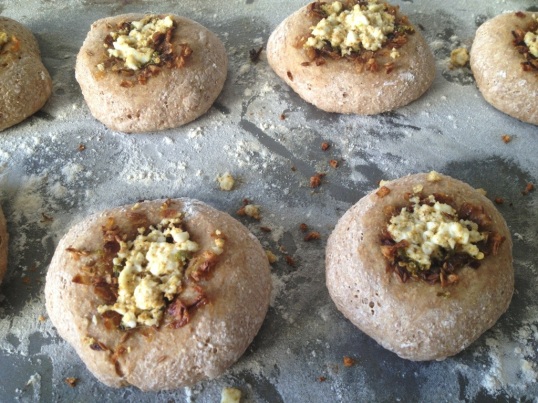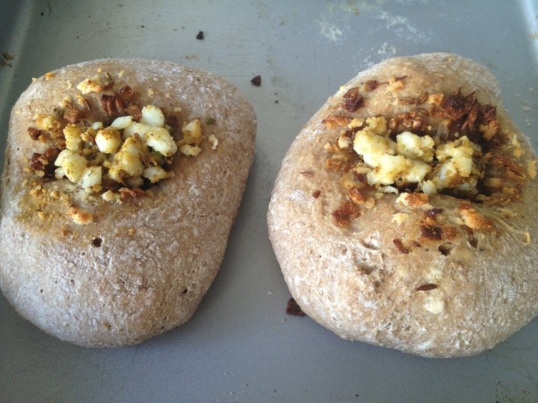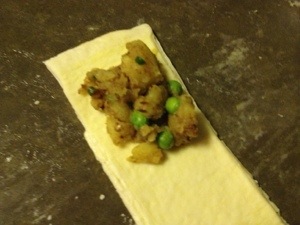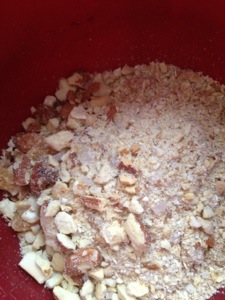 This was a new one for me. I had not heard of Bialys before Aparna introduced it to me in this month’s We Knead to Bake Project.
This was a new one for me. I had not heard of Bialys before Aparna introduced it to me in this month’s We Knead to Bake Project.
Bialy, a Yiddish word short for bialystoker kuchen, from Białystok, a city in Poland, is a small roll that is a traditional dish in Polish Ashkenazi cuisine. In the early 1900s, many Eastern Eurpoeans, including the Polish, immigrated to the US and settled down in New York bringing their Bialy making skills with them. And that is how the New York Bialy became famous. There you go, that’s a mini history lesson on Bialys for you.
For those new to Bialys like me, they look and maybe taste close to a bagel, but there are some differences. For one, a Bialy doesn’t have a hole in the middle like a bagel but is depressed in the center with a filling (usually onions, garlic, poppy seeds etc). A Bagel is boiled and then baked while a Bialy is just baked. According to Aparna – a good Bialy should have a springy soft crumb but a chewy and floury crust.
I haven’t made bagels from scratch either so I wouldn’t know the actual differences in process but I was quite excited to try these out this past month. These were quite easy to make except for the rising time (still doesn’t beat the croissant process:) and of course, Aparna had Indianized it a bit by adding paneer and garam masala so I couldn’t wait to try this bread.
I added green chili (of course, for the spice), paneer, caramelized onions and stuffed paratha masala. It tasted like a paneer kulcha in a bagel form if you know what I mean. The paneer and stuffed paratha masala was a great combo and complimented each other quite well. Here’s the recipe (Adapted from King Arthur Flour) http://www.kingarthurflour.com/recipes/bialys-recipe
Ingredients:
For the dough:
1 teaspoon instant yeast
1 tbsp sugar
1 1/4 cup water
3 cups all-purpose flour (use bread flour if you can find it or all-purpose flour + 1 tbsp vital wheat gluten)- I used 3 cups of wholemeal bread flour
1 tsp salt
Milk for brushing the dough
For the Onion Filling:
1 tbsp oil
3 medium onions, finely chopped
1 1/2 tsp cumin seeds
3/4 tsp stuffed paratha masala
3 green chili crushed or minced
Salt to taste
100gm paneer, crumbled (optional)
Method:
1. Put the yeast, sugar, salt and flour in a stand mixer or food processor bowl. Pulse a couple of times to mix and then add the warm water in a steady stream. Knead until the dough comes together as a mass and then let the dough rest for 10 minutes. This will help the dough absorb water. Knead again, adding a little more water or flour (not too much) if you need it, until your dough is smooth and elastic but not sticky.
2. Shape it into a ball and put it in a well-oiled bowl, turning the dough till it is well coated. Cover and let it rise till about double. This should take about 2 hours.
If you’re not making the Bialys right away, you can refrigerate the dough overnight at this point. When ready to make them, keep the dough at room temperature for about half an hour and then proceed with the rest of the recipe.
3. In the meanwhile, make the filling. Heat the oil in a pan, and add the cumin seeds. When the crackle, add the onions, and sauté over low to medium heat. Sprinkle a little salt and continue sautéing until they become soft and turn golden brown in colour. Add the stuffed paratha masala and stir well. Keep the caramelised onions aside to cool.
4. Sprinkle your work surface lightly with flour and place the dough on it. Divide it into 8 equal pieces and shape each one into a roll by flattening it and then pinching the ends together to form a smooth ball.
(See this video for shaping rolls, if necessary http://www.youtube.com/watch?v=TB908K3Kd6k )
5. Place the rolls on a lightly greased baking sheet and cover them with a towel. Let them rise for about one hour (about 1 1/2 to 2 hours for refrigerated dough) till pressing with a finger on the top leaves a dent.
6. Work on one piece at a time, while you keep the others covered so they don’t dry out. When the rolls are ready, pick them up one at a time and using your fingers, form the depression in the middle. Hold the roll like a steering wheel with your thumbs in the middle and your fingers around the edges. Pinch the dough between your thumb and fingers, rotating as you go and gradually making the depression wider without actually poking a hole through. The depression should be quite thin so the filling can stay in and not rise when the Bialy bakes.
Remember not to press on the edges, or they will flatten out. Once shaped, you should have a depression about 3” in diameter with 1” of puffy dough around the edge, so your Bialy should be about 4” in diameter. Prick the centre of the Bialy with a fork so the centre doesn’t rise when baking.
7. Place the shaped dough on a parchment lined (or greased) baking tray leaving about 2 inches space between them.
8. Place the caramelized onion filling in the depressions of each Bialy. Add some mined green chili to each as a topping. Brush the outer dough circle with milk. If you’re using crumbled paneer, add it to the Bialys in the last 5 minutes of baking or it will get burnt.

Bake the Bialys at 230C (450F) for about 15 minutes till they’re golden brown in color. Cool them on a rack. Serve slightly warm or at room temperature. This recipe makes 8 largish Bialys.
Enjoy warm with butter or cream cheese.

0.000000
0.000000





































